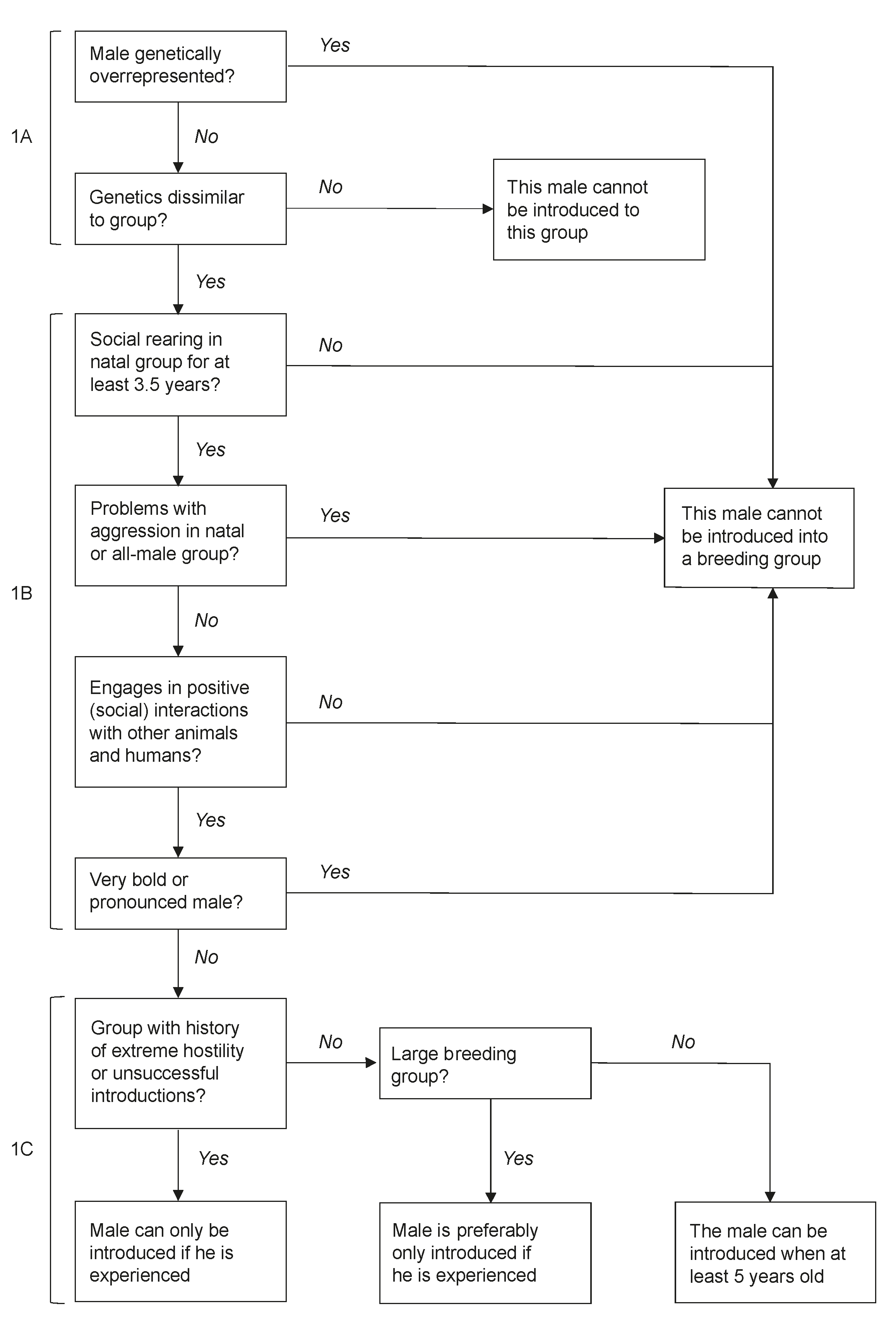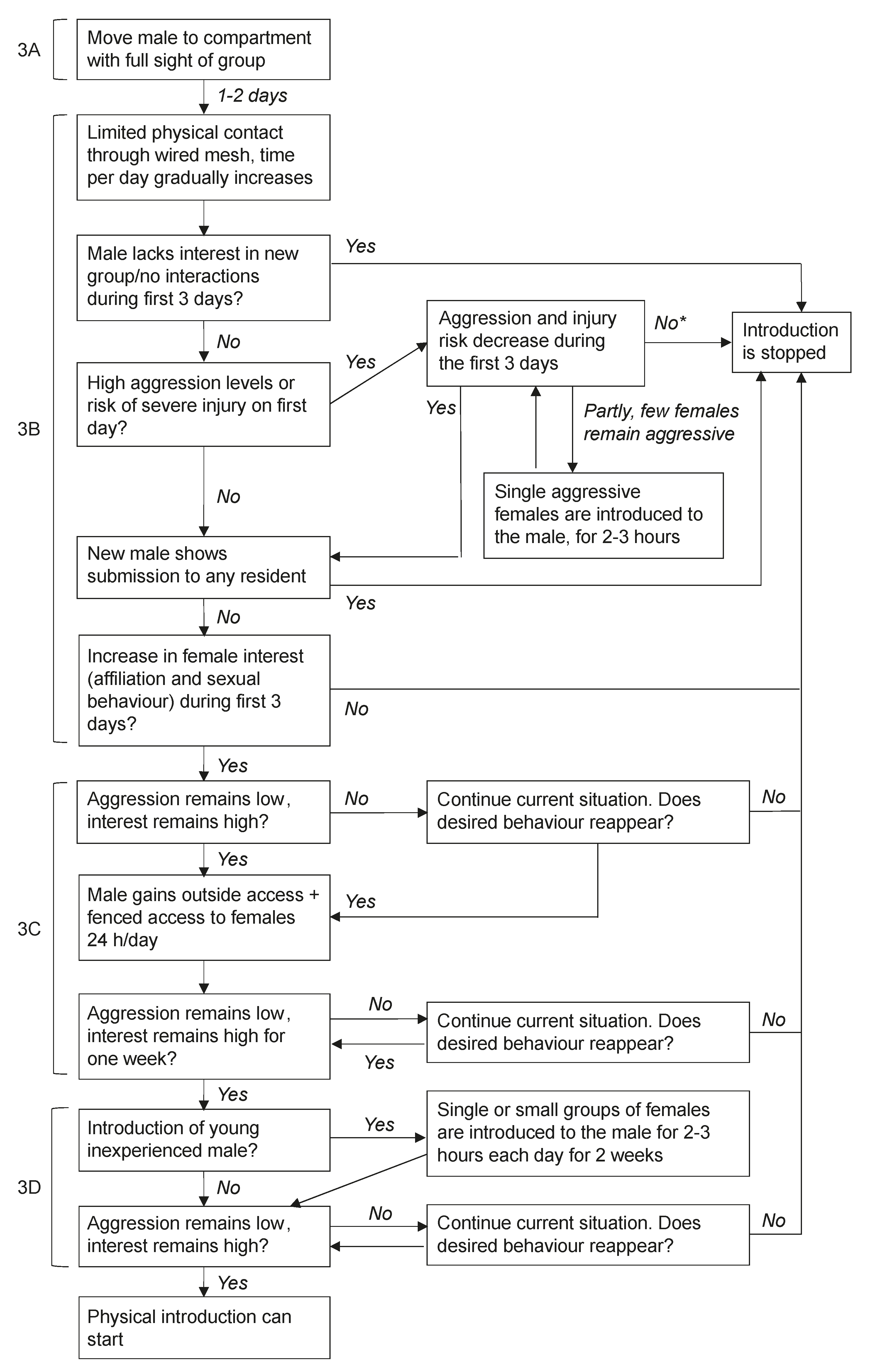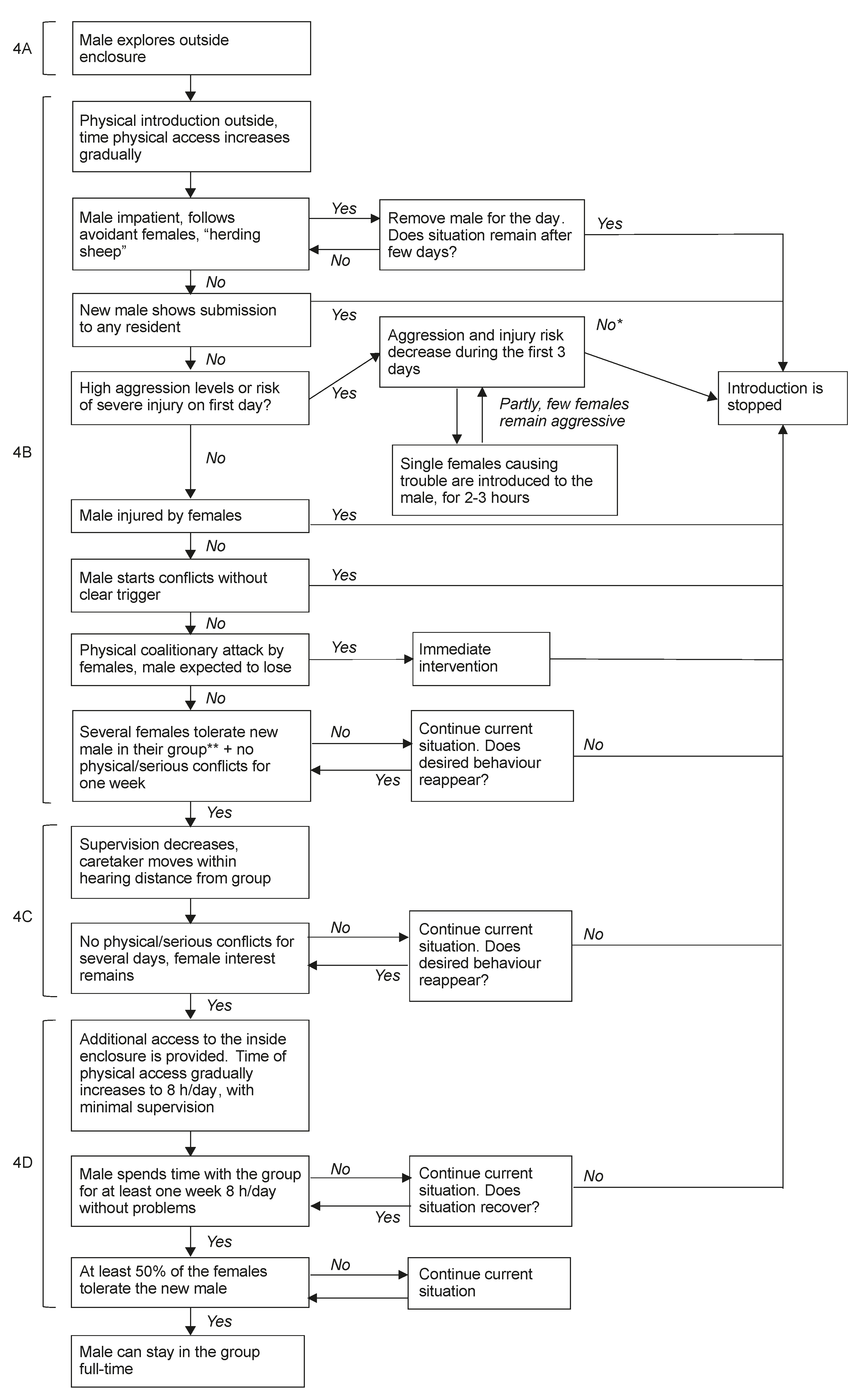A Stepwise Male Introduction Procedure to Prevent Inbreeding in Naturalistic Macaque Breeding Groups
Abstract
Simple Summary
Abstract
1. Introduction
2. Methods
2.1. Housing Conditions
2.2. Developing the BPRC Introduction Procedure
2.3. Conducting Male Introductions at the BPRC
2.4. Male Introduction Procedure
- Step 1.
- Selecting a Breeding Male
- Step 2.
- Preparing the Male and the Group for the Introduction
- Step 3.
- Familiarizing the New Male and the Group
- Step 4.
- Physically Introducing the New Male
- Step 5.
- Post-Introduction Monitoring
3. Discussion
Author Contributions
Funding
Institutional Review Board Statement
Informed Consent Statement
Data Availability Statement
Acknowledgments
Conflicts of Interest
References
- Barnett, S.A. The Rat: A Study in Behavior, Revised ed.; Australian National University Press: Canberra, Australia, 1976. [Google Scholar]
- Kempes, M.M.; Gulickx, M.M.; Van Daalen, H.J.; Louwerse, A.L.; Sterck, E.H. Social competence is reduced in socially deprived rhesus monkeys (Macaca mulatta). J. Comp. Psychol. 2008, 122, 62–67. [Google Scholar] [CrossRef]
- Mineka, S.; Suomi, S.J. Social separation in monkeys. Psychol. Bull. 1978, 85, 1376–1400. [Google Scholar] [CrossRef] [PubMed]
- Taylor, S.E. Mechanisms linking early life stress to adult health outcomes. Proc. Natl. Acad. Sci. USA 2010, 107, 8507–8512. [Google Scholar] [CrossRef] [PubMed]
- Russel, W.M.S.; Burch, R.L. The Principles of Humane Experimental Technique. Med. J. Aust. 1960, 1, 500. [Google Scholar] [CrossRef]
- Bracke, M.B.M.; Hopster, H. Assessing the Importance of Natural Behavior for Animal Welfare. J. Agric. Environ. Ethic. 2006, 19, 77–89. [Google Scholar] [CrossRef]
- Fraser, D. Understanding animal welfare. Acta Vet. Scand. 2008, 50, S1–S7. [Google Scholar] [CrossRef]
- Olsson, I.A.S.; Westlund, K. More than numbers matter: The effect of social factors on behaviour and welfare of laboratory rodents and non-human primates. Appl. Anim. Behav. Sci. 2007, 103, 229–254. [Google Scholar] [CrossRef]
- Rennie, A.E.; Buchanan-Smith, H.M. Refinement of the use of non-human primates in scientific research. Part II: Housing, husbandry and acquisition. Anim. Welf. 2006, 15, 215–238. [Google Scholar]
- Fernández-Duque, E.; Di Fiore, A.; Huck, M. The behavior, ecology, and social evolution of cercopithecne monkeys. In The Evolution of Primate Societies; Mitani, J.C., Call, J., Eds.; University of Chicago Press: Chicago, IL, USA, 2012. [Google Scholar] [CrossRef]
- Keane, B.; Dittus, W.P.J.; Melnick, D.J. Paternity assessment in wild groups of toque macaques Macaca sinica at Polonnaruwa, Sri Lanka using molecular markers. Mol. Ecol. 1997, 6, 267–282. [Google Scholar] [CrossRef] [PubMed]
- Lindburg, D.G. Rhesus Monkeys: Mating Season Mobility of Adult Males. Science 1969, 166, 1176–1178. [Google Scholar] [CrossRef]
- Ménard, N.; Vallet, D. Dynamics of fission in a wild Barbary macaque group (Macaca sylvanus). Int. J. Primatol. 1993, 14, 479–500. [Google Scholar] [CrossRef]
- Neville, M.K. A Free-Ranging Rhesus Monkey Troop Lacking Adult Males. J. Mammal. 1968, 49, 771–773. [Google Scholar] [CrossRef]
- Singh, M.; Kumara, H.N.; Kumar, M.A.; Singh, M.; Cooper, M. Male Influx, Infanticide, and Female Transfer in Macaca radiata radiata. Int. J. Primatol. 2006, 27, 515–528. [Google Scholar] [CrossRef]
- Van Noordwijk, M.A.; Van Schaik, C.P. Male migration and rank acquisition in wild long-tailed macaques (Macaca fascicularis). Anim. Behav. 1985, 33, 849–861. [Google Scholar] [CrossRef]
- Boelkins, R.C.; Wilson, A.P. Intergroup social dynamics of the Cayo Santiago rhesus (Macaca mulatta) with special reference to changes in group membership by males. Primates 1972, 13, 125–139. [Google Scholar] [CrossRef]
- Tuttle, R.H. Socioecology and Psychology of Primates. In Socioecology and Psychology of Primates; Walter de Gruyter GmbH: Berlin, Germany, 1975; pp. 125–152. [Google Scholar]
- Drickamer, L.C.; Vessey, S.H. Group changing in free-ranging male rhesus monkeys. Primates 1973, 14, 359–368. [Google Scholar] [CrossRef]
- Hayakawa, S.; Soltis, J. Troop Takeover and Reproductive Success of Wild Male Japanese Macaques on Yakushima Island (Macaca fuscata yakui). Int. J. Zool. 2011, 2011, 1–8. [Google Scholar] [CrossRef]
- Mehlman, P. Male intergroup mobility in a wild population of the Barbary macaque (Macaca sylvanus), Ghomaran rif mountains, Morocco. Am. J. Primatol. 1986, 10, 67–81. [Google Scholar] [CrossRef]
- Sprague, D.S. Life history and male intertroop mobility among Japanese macaques (Macaca fuscata). Int. J. Primatol. 1992, 13, 437–454. [Google Scholar] [CrossRef]
- Van Noordwijk, M.A.; Van Schaik, C.P. Career moves: Transfer and rank challenge decisions by male long-tailed macaques. Behaviour 2001, 138, 359–395. [Google Scholar]
- McCowan, B.; Beisner, B.; Hannibal, D. Social management of laboratory rhesus macaques housed in large groups using a network approach: A review. Behav. Process. 2018, 156, 77–82. [Google Scholar] [CrossRef]
- Rox, A.; Van Vliet, A.H.; Sterck, E.H.M.; Langermans, J.; Louwerse, A.L. Factors determining male introduction success and long-term stability in captive rhesus macaques. PLoS ONE 2019, 14, e0219972. [Google Scholar] [CrossRef]
- Mehlman, P.T.; Higley, J.D.; Faucher, I.; A Lilly, A.; Taub, D.M.; Vickers, J.; Suomi, S.J.; Linnoila, M. Correlation of CSF 5-HIAA concentration with sociality and the timing of emigration in free-ranging primates. Am. J. Psychiatry 1995, 152, 907–913. [Google Scholar] [CrossRef]
- Sprague, D.S.; Suzuki, S.; Takahashi, H.; Sato, S. Male life history in natural populations of Japanese macaques: Migration, dominance rank, and troop participation of males in two habitats. Primates 1998, 39, 351–363. [Google Scholar] [CrossRef]
- Bernstein, I.S.; Rose, R.M.; Gordon, T.P. Behavioural and hormonal responses of male rhesus monkeys introduced to females in the breeding and non-breeding seasons. Anim. Behav. 1977, 25, 609–614. [Google Scholar] [CrossRef]
- Cooper, M.A.; Bernstein, I.S.; Fragaszy, D.M.; De Waal, F.B.M. Integration of New Males into Four Social Groups of Tufted Capuchins (Cebus apella). Int. J. Primatol. 2001, 22, 663–683. [Google Scholar] [CrossRef]
- Zaunmair, P.; Mangalam, M.; Kaumanns, W.; Singh, M.; Slotta-Bachmayr, L. Patterns of dominance relationships among the females of a captive female-only group of lion-tailed macaques (Macaca silenus) during the course of the introduction of a new adult male. Curr. Sci. 2015, 109, 803–807. [Google Scholar]
- Alberts, S.C.; Sapolsky, R.M.; Altmann, J. Behavioral, endocrine, and immunological correlates of immigration by an aggressive male into a natural primate group. Horm. Behav. 1992, 26, 167–178. [Google Scholar] [CrossRef] [PubMed][Green Version]
- Beehner, J.; Bergman, T.; Cheney, D.; Seyfarth, R.; Whitten, P. The effect of new alpha males on female stress in free-ranging baboons. Anim. Behav. 2005, 69, 1211–1221. [Google Scholar] [CrossRef]
- Marty, P.R.; Hodges, K.; Heistermann, M.; Agil, M.; Engelhardt, A. Is social dispersal stressful? A study in male crested macaques (Macaca nigra). Horm. Behav. 2017, 87, 62–68. [Google Scholar] [CrossRef]
- Prescott, M.J.; Nixon, M.E.; Farningham, D.A.; Naiken, S.; Griffiths, M.-A. Laboratory macaques: When to wean? Appl. Anim. Behav. Sci. 2012, 137, 194–207. [Google Scholar] [CrossRef]
- Veenema, A.H. Early life stress, the development of aggression and neuroendocrine and neurobiological correlates: What can we learn from animal models? Front. Neuroendocr. 2009, 30, 497–518. [Google Scholar] [CrossRef]
- Oates-O’Brien, R.S.; Farver, T.B.; Anderson-Vicino, K.C.; McCowan, B.; Lerche, N.W. Predictors of Matrilineal Overthrows in Large Captive Breeding Groups of Rhesus Macaques (Macaca mulatta). J. Am. Assoc. Lab. Anim. Sci. 2010, 49, 196–201. [Google Scholar]
- Reinhardt, V.; Liss, C.; Stevens, C. Social housing of previously single-housed macaques: What are the options and the risks? Anim. Welf. 1995, 4, 307–328. [Google Scholar]
- Truelove, M.A.; Martin, A.L.; Perlman, J.E.; Wood, J.S.; Bloomsmith, M.A. Pair housing of Macaques: A review of partner selection, introduction techniques, monitoring for compatibility, and methods for long-term maintenance of pairs. Am. J. Primatol. 2017, 79, 1–15. [Google Scholar] [CrossRef]
- Jack, K.M.; Fedigan, L. Male dispersal patterns in white-faced capuchins, Cebus capucinus Part 2: Patterns and causes of secondary dispersal. Anim. Behav. 2004, 67, 771–782. [Google Scholar] [CrossRef]
- Bernstein, I. Introductory Techniques in the formation of pigtail monkey troops. Folia Primatol. 1969, 10, 1–19. [Google Scholar] [CrossRef] [PubMed]
- Vernes, M.K.; Louwerse, A.L. BPRC’s Enrichment Manual for Macaques and Marmosets; Biomedical Primate Research Centre: Rijswijk, The Netherlands, 2010. [Google Scholar]
- de Groot, N.; Stanbury, K.; de Vos-Rouweler, A.J.; de Groot, N.G.; Poirier, N.; Blancho, G.; de Luna, C.; Doxiadis, G.G.M.; Bontrop, R.E. A quick and robust MHC typing method for free-ranging and captive primate species. Immunogenetics 2017, 69, 231–240. [Google Scholar] [CrossRef][Green Version]
- de Groot, N.G.; Blokhuis, J.H.; Otting, N.; Doxiadis, G.G.; Bontrop, R.E. Co-evolution of the MHC class I and KIR gene families in rhesus macaques: Ancestry and plasticity. Immunol. Rev. 2015, 267, 228–245. [Google Scholar] [CrossRef]
- Ballou, J.D.; Lees, C.; Faust, L.J.; Long, S.; Lynch, C.; Bingaman Lackey, L.; Foose, T.J. Demographic and genetic management of captive populations. In Wild Mammals in Captivity: Principles and Techniques for Zoo Management, 2nd ed.; Kirk Baer, C., Ed.; University of Chicago Press: Chicago, IL, USA, 2010; pp. 219–252. [Google Scholar]
- Setchell, J.M.; Huchard, E. The hidden benefits of sex: Evidence for MHC-associated mate choice in primate societies. BioEssays 2010, 32, 940–948. [Google Scholar] [CrossRef]
- Marty, P.R.; Hodges, K.; Agil, M.; Engelhardt, A. Alpha male replacements and delayed dispersal in crested macaques (Macaca nigra). Am. J. Primatol. 2015, 79, e22448. [Google Scholar] [CrossRef] [PubMed]
- Sterck, E.H.M.; Bontrop, R.E.; De Groot, N.; De Vos-Rouweler, A.J.M.; Doxiadis, G.G.M. No postcopulatory selection against MHC-homozygous offspring: Evidence from a pedigreed captive rhesus macaque colony. Mol. Ecol. 2017, 26, 3785–3793. [Google Scholar] [CrossRef]
- Silk, J.B. Kin selection in primate groups. Int. J. Primatol. 2002, 23, 849–875. [Google Scholar] [CrossRef]
- Silk, J.B.; Altmann, J.; Alberts, S.C. Social relationships among adult female baboons (papio cynocephalus) I. Variation in the strength of social bonds. Behav. Ecol. Sociobiol. 2006, 61, 183–195. [Google Scholar] [CrossRef]
- Suomi, S.J. Mother-Infant Attachment, Peer Relationships, and the Development of Social Networks in Rhesus Monkeys. Hum. Dev. 2005, 48, 67–79. [Google Scholar] [CrossRef]
- Davenport, M.D.; Tiefenbacher, S.; Lutz, C.K.; Novak, M.A.; Meyer, J.S. Analysis of endogenous cortisol concentrations in the hair of rhesus macaques. Gen. Comp. Endocrinol. 2006, 147, 255–261. [Google Scholar] [CrossRef]
- Rox, A.; De Vries, H.; Louwerse, A.L.; Sterck, E.H. Female social behaviour during three male introductions in captive groups of rhesus macaques. Appl. Anim. Behav. Sci. 2018, 207, 89–97. [Google Scholar] [CrossRef]
- Bernstein, I.S.; Gordon, T.P.; Rose, R.M. The Interaction of Hormones, Behavior, and Social Context in Nonhuman Primates. In Hormones and Aggressive Behavior; Springer International Publishing: Cham, Switzerland, 1983; pp. 535–561. [Google Scholar]
- Bernstein, I.S. The influence of introductory techniques on the formation of captive mangabey groups. Primates 1971, 12, 33–44. [Google Scholar] [CrossRef]
- Rutte, C.; Taborsky, M.; Brinkhof, M.W. What sets the odds of winning and losing? Trends Ecol. Evol. 2006, 21, 16–21. [Google Scholar] [CrossRef]
- Thierry, B. Unity in diversity: Lessons from macaque societies. Evol. Anthr. Issues News Rev. 2007, 16, 224–238. [Google Scholar] [CrossRef]





Publisher’s Note: MDPI stays neutral with regard to jurisdictional claims in published maps and institutional affiliations. |
© 2021 by the authors. Licensee MDPI, Basel, Switzerland. This article is an open access article distributed under the terms and conditions of the Creative Commons Attribution (CC BY) license (http://creativecommons.org/licenses/by/4.0/).
Share and Cite
Rox, A.; van Vliet, A.H.; Langermans, J.A.M.; Sterck, E.H.M.; Louwerse, A.L. A Stepwise Male Introduction Procedure to Prevent Inbreeding in Naturalistic Macaque Breeding Groups. Animals 2021, 11, 545. https://doi.org/10.3390/ani11020545
Rox A, van Vliet AH, Langermans JAM, Sterck EHM, Louwerse AL. A Stepwise Male Introduction Procedure to Prevent Inbreeding in Naturalistic Macaque Breeding Groups. Animals. 2021; 11(2):545. https://doi.org/10.3390/ani11020545
Chicago/Turabian StyleRox, Astrid, André H. van Vliet, Jan A. M. Langermans, Elisabeth H. M. Sterck, and Annet L. Louwerse. 2021. "A Stepwise Male Introduction Procedure to Prevent Inbreeding in Naturalistic Macaque Breeding Groups" Animals 11, no. 2: 545. https://doi.org/10.3390/ani11020545
APA StyleRox, A., van Vliet, A. H., Langermans, J. A. M., Sterck, E. H. M., & Louwerse, A. L. (2021). A Stepwise Male Introduction Procedure to Prevent Inbreeding in Naturalistic Macaque Breeding Groups. Animals, 11(2), 545. https://doi.org/10.3390/ani11020545





